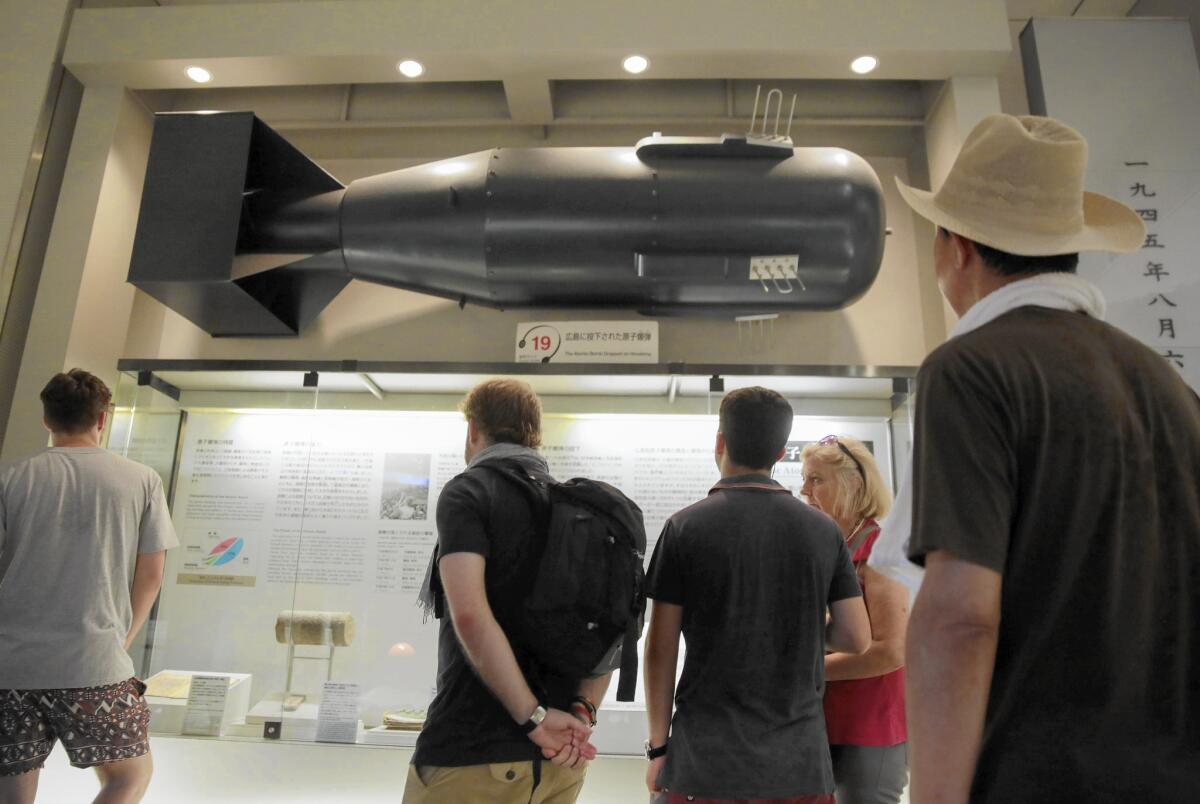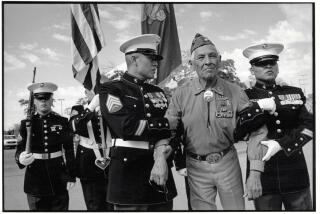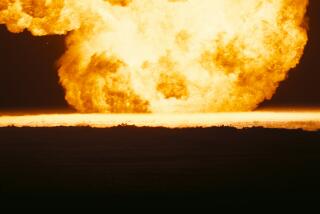New evidence of Japan’s effort to build atom bomb at the end of WWII

A replica of the American atom bomb code-named “Little Boy,” which was dropped on Hiroshima, is on display at the city’s Peace Memorial Museum.
In August 1945, the U.S. dropped atom bombs on Hiroshima and Nagasaki. Now, as Japan and the rest of the world prepare to mark seven decades since the end of World War II in the Pacific, new evidence has emerged about the Japanese military’s own secret program to build a nuclear weapon.
A retired professor at the state-run Kyoto University recently discovered a blueprint at the school’s former Radioisotope Research lab, Japan’s Sankei newspaper and other local media reported recently.
The notebooks were related to research work by Bunsaku Arakatsu, a professor at the university whom Sankei said was asked by the Japanese navy to develop an atomic bomb during the war.
Also found were drawings of a turbine-based centrifuge apparently to be used for the study of uranium enrichment. It was dated March 1945. Another blueprint was found of a centrifuge that a Japanese company, Tokyo Keiki, was producing, with a notation indicating the device was scheduled to be completed Aug. 19, 1945 — four days after Japan announced that it was surrendering.
Experts say the material buttresses information contained in U.S. archives and casts light on the direction the research was headed.
For some, the documents also have contemporary resonance, and are a painful reminder that Japan was headed toward developing the same kind of intensely destructive weapons the United States had.
The disclosures come as Japan is in the midst of national debates on nuclear activities and on the use of soldiers.
Japanese parliament members are weighing whether to reinterpret the constitution to allow Japan’s Self-Defense Forces to fight abroad with strategic allies such as the United States. Meanwhile, the country is considering whether to restart its nuclear power plants, idled since a meltdown at Fukushima after the devastating 2011 earthquake and tsunami.
“These drawings are more confirmation of the Japanese atomic bomb effort, something many in Japan do not want to admit,” said Robert K. Wilcox, the L.A. based- author of “Japan’s Secret War: Japan’s Race Against Time to Build Its Own Atomic Bomb.”
Wilcox, who has been researching the program for decades, said Japan’s problem was not a lack of know-how.
“They knew the physics needed for creating the bomb and the engineering needed to build it,” he said. “It was lack of element resources like uranium that was the real problem for them.”
Such supplies were not readily available in Japan so its leaders looked toward occupied territories.
“In 1945, the Japanese navy alone spent a fortune to gather uranium,” Wilcox said. “They needed a win-the-war weapon and an atomic bomb was seen as one of those.”
The Japanese government burned thousands of documents as the war was ending. Researchers believe many documents related to Japan’s atomic bomb program were destroyed. U.S. occupation forces confiscated almost anything that remained.
So the documents discovered in Japan have drawn intense interest.
“We can say the blueprint is a monument to the elementary levels the research reached at the early stages,” Masakatsu Yamazaki, an expert on nuclear development history and an emeritus professor at Tokyo Kogyo University told the Sankei. “It’s historically meaningful and it’s amazing that it remained.”
After the American bombings, there was little public discussion about Japan’s attempts to develop an atomic bomb. But Wilcox and Japanese scholars who have since studied the matter say there were two programs to produce a nuclear weapon.
The first plan was commissioned by the Japanese navy and code-named F Research, which involved Arakatsu, the professor. The Japanese army carried out the other program, known as the Nigo Research project, headed by Yoshio Nishina, a physicist at the Riken Institute in Tokyo.
Some scholars believe Japan could have made a nuclear bomb if it had succeeded in acquiring uranium and been able to enrich it. Two major setbacks delayed progress, researchers and those involved in the programs have said.
Masa Takeuchi, who had played a central role in researching thermal diffusion under Nishina, said in the 1960s that Japanese researchers had completed a thermal diffusion device that would have allowed extraction of uranium 235 as early as 1944, but U.S. bombings destroyed their secret facilities.
The other problem was that Japan couldn’t get enough uranium to move forward, another researcher, Kunihiko Higoshi of Gakushuin University, said in 2013.
“Nishina told us that a U-boat from Germany would bring us the uranium. It never arrived,” Higoshi said.
On May 19, 1945, a Nazi submarine was captured and discovered to be delivering 1,200 pounds of uranium oxide to the Japanese military. The vessel was dispatched for Japan shortly after Adolf Hitler committed suicide, a time when the Germans wanted to dispose of their large amounts of uranium. Two Japanese officers were aboard the submarine; both committed suicide upon being captured.
In an article published in October 1946, the Atlanta Constitution cited an unidentified Japanese officer as saying that U.S. air raids on Japan forced the military to move its bomb plant to Japanese-occupied territory in what is now North Korea, delaying Tokyo’s bomb development schedule by three months.
Most experts believe that Japan did not have the capability to build a nuclear weapon before the U.S. bombings.
Takeuchi told the Yomiuri newspaper that when he heard that “a new type of bomb” had been dropped on Hiroshima, he thought to himself, ‘How the hell did the U.S. come up with an atomic bomb!’
“It was overwhelmingly regrettable and frustrating,” he said.
When Japan surrendered, the occupying U.S. forces discovered just five cyclotrons, devices that speed up atoms in order to separate isotopes that can then be used for a bomb. U.S. atomic facilities in New Mexico, by comparison, contained hundreds of separators operating day and night to produce just four bombs.
“I don’t think Japan’s nuclear program was very advanced or that it played a role in the decision to bomb Hiroshima and Nagasaki,” said Jeff Kingston, director of Asian Studies at Temple University’s Japan Campus, and author of “Contemporary Japan.”
The uranium seized from the German submarine ended up in the American atom bombs, John Lansdale Jr., head of security for the Manhattan Project, said in a 1995 New York Times interview.
Chieko Takeuchi, widow of the atomic scientist, recalled her husband saying, “If we’d built the bomb first, of course we would have used it. I’m glad, in some ways, that our facilities were destroyed.”
Adelstein is a special correspondent.
ALSO:
For China’s gay men, Dongdan Park in Beijing offers haven
Russia claims vast Arctic territory, seeks U.N. recognition
Island building in disputed sea? China doesn’t want to talk about it
More to Read
Start your day right
Sign up for Essential California for news, features and recommendations from the L.A. Times and beyond in your inbox six days a week.
You may occasionally receive promotional content from the Los Angeles Times.






